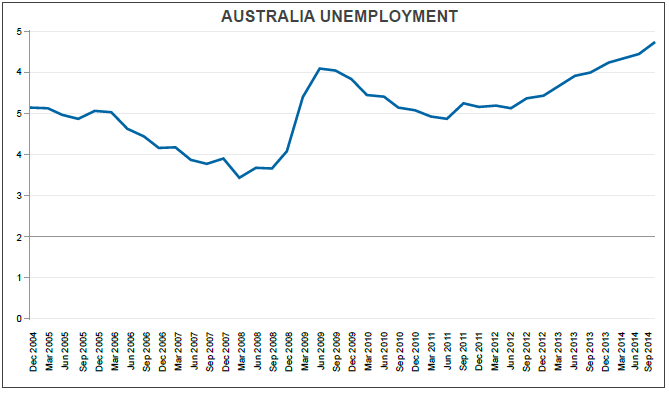Falling in commodity prices led to a budget blow out and will likely impact growth, causing headaches for the RBA.
GROWTH EXPECTATIONS:
GDP, a mainstay of economic development, had beenshowing some strong results in the previous quarter asit lifted, despite most people believing it would worsen.However, the November reading came in at 0.3% (0.7%exp), which was much weaker than expected. Going forward, it’s likely we will see further volatility in GDP results as the Australian economy suffers.

Retail sales have continued to be stronger than expectedwith October’s reading coming in at 1.2% and November’sreading at 0.4%, both well above expectations. The retailsales in Australia have come as a surprise overall, as thedomestic market had been struggling for some time.
Unemployment has begun to worsen in the Australianeconomy and since the last quarterlyreport, it has lifted0.2% to 6.3% with many expecting that further rises maybe possible as commodity prices continue to decline.The RBA and the government will be watching this oneclosely as many are starting to get significantly worried about Australia’s labour market.

Chinese manufacturing PMI data has so far been robust,despite recent talks of a slowdown in China. With themost recent figures coming in at 50.1 showing there isstill expansion in China, however, this could taper off in2015, and we anticipate that results for manufacturingwill remain suppressed.
MONETARY POLICY:
The Reserve Bank of Australia (RBA) has maintained aneutral policy throughout 2014 as it looks to push the AUDlower. It has managed to jaw-bone the dollar repeatedly,but going forward, it still remains more elevated than whatthe RBA is comfortable with. Many are now anticipatingthat we could see a rate cut from the RBA as inflation islow. Additionally, if there is no movement lower, somedeputy governors have suggested currency interventionas a possible solution.
FISCAL POLICY:
Fiscal policy in Australia has worsened heavily ascommodity prices have fallen, impacting tax receipts.The current 2014 budget blow out is expected to be around 40 billion dollars (AUD) and Australia is now expecting a 17/18 billion budget blowout for 2015 despite recent aggressive cutting from the government budget.Australia is not expected to produce a 1% GDP budget until mid-2020’s, so it seems the Australian government is going to struggle for some time, especially with its unpopular stance as of late.
FX OUTLOOK:
The RBA has postured itself in a neutral stance for 2014,and 2015 is looking to be different as Australia’s woescontinue. As a result, we see the RBA trying to talk downthe dollar further as well as looking to put pressure onthe currency via other additional measures, such as aninterest rate cut, or even currency intervention. Overall,the bearish outlook from last year is likely to carry overfor some time until there is an improvement in the stateof the Australian economy.
